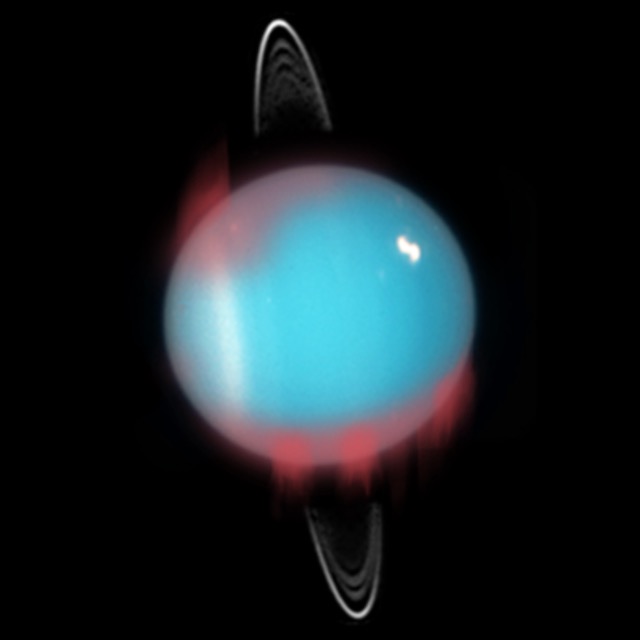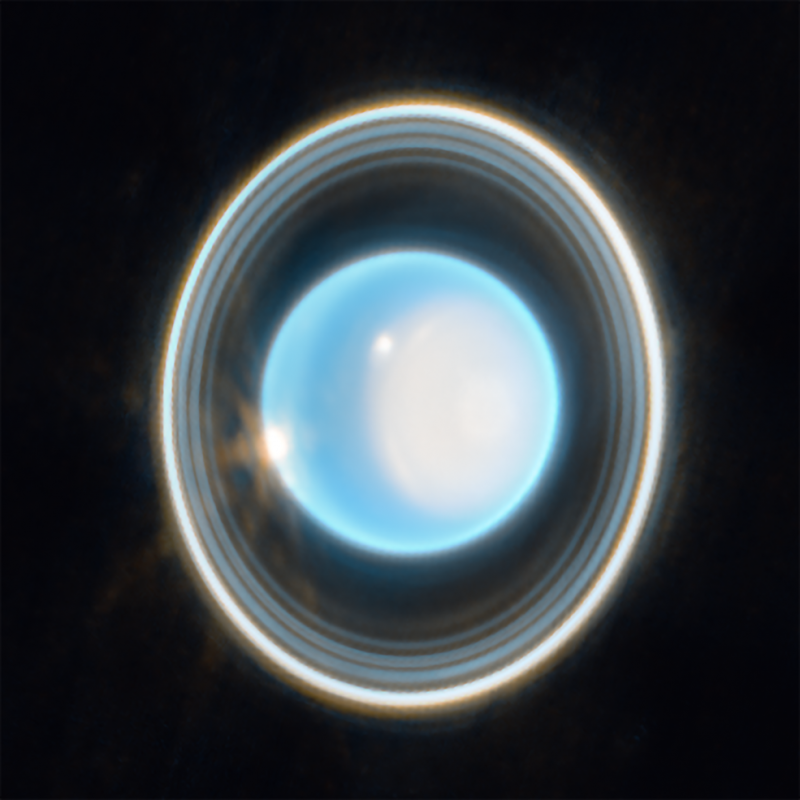
Astronomers have known since the 1980s that Uranus – the 7th planet – has auroras. But – unlike auroras, aka northern lights, here on Earth – Uranus’ auroras were known only via observations of high-energy ultraviolet light. And of course we can’t see that form of light with the eye. Now comes another new discovery of auroras on Uranus, also invisible to the eye. These are infrared auroras. On October 26, 2023, scientists in the U.K., led by researchers at the University of Leicester, said they caught the infrared auroras – a first-ever discovery – using a Keck telescope in Hawaii.
How did the researchers do it? And what does it mean? Keep reading …
The researchers published their peer-reviewed findings in the journal Nature Astronomy on October 23.
The 2024 lunar calendars are here! Best Christmas gifts in the universe! Check ’em out here.
Elusive infrared auroras for Uranus
Uranus’ ultraviolet auroras aren’t just known … they are well-known. NASA’s Voyager 2 spacecraft first spied them back in 1986. But astronomers had never detected infrared auroras on the ice giant planet … until now. The researchers used the NIRSPEC instrument, a cross-dispersed echelle spectrograph on the Keck II Telescope in Hawaii, which provides high-enough resolution to detect the elusive auroras.
They analyzed specific wavelengths of light, called emission lines, coming from Uranus. They can then study that light in a manner similar to how a barcode works.
The researchers used images first taken by Keck II on September 5, 2006.
So how do the researchers detect infrared auroras specifically, if they are there? They look for charged particles called H3+, or three hydrogen nuclei with two electrons. The temperature of these charged particles can affect how bright they are. This also provides clues as to how dense the atmosphere is at the location of the particles.
If there was an increase in the density of the atmosphere, but either no or very little change in temperature, then that would most likely be due to infrared auroras. Astronomers know auroras cause ionization, resulting in the change in atmospheric density, but no change in temperature.
Why are these auroras in the infrared? Basically, it’s because the atmosphere is mostly a mix of hydrogen and helium. This mix causes the auroras to emit light outside the visible spectrum, in wavelengths such as infrared.
Giant planets warmer than expected
The auroras may also help solve another mystery. All four of the giant planets – Jupiter, Saturn, Uranus and Neptune – are warmer than theoretical models suggest they should be. Why? Lead author Emma Thomas at the University of Leicester said:
The temperature of all the gas giant planets, including Uranus, are hundreds of degrees Kelvin/Celsius above what models predict if only warmed by the sun, leaving us with the big question of how these planets are so much hotter than expected. One theory suggests the energetic aurora is the cause, which generates and pushes heat from the aurora down toward the magnetic equator.
Auroras on Uranus and implications for Neptune
The results from Uranus can be applied to the other ice giant, Neptune. The paper stated:
This likely detection of H3+ aurora at Uranus has broader implications for Neptune, given the planet’s similarities (similar unaligned and offset magnetic fields). Currently, we have not detected H3+ at Neptune, the cause suggested to be a cooler-than-expected upper atmosphere. The presence of infrared aurora at Uranus suggests the potential for detecting aurora at Neptune, where past observations may have been taken during weak emission periods.
What about exoplanets?
The astronomers said their discovery could help astronomers assess whether some exoplanets – or planets orbiting distant stars – are potentially habitable. This possible future assessment particularly applies to sub-Neptune sized worlds. The paper said:
Confirming infrared aurora at Uranus directly assists in exoplanetary advancements as warm-ice-giant worlds make up a large fraction of the current population. Auroral detections from exoplanets could provide upper atmospheric diagnostics. A detailed understanding of Uranus could advance exoplanet knowledge, helping the wider scientific community to understand their ionospheric compositions.
Thomas also said:
This paper is the culmination of 30 years of auroral study at Uranus, which has finally revealed the infrared aurora and begun a new age of aurora investigations at the planet. Our results will go on to broaden our knowledge of ice-giant auroras and strengthen our understanding of planetary magnetic fields in our solar system, at exoplanets and even our own planet.
A majority of exoplanets discovered so far fall in the sub-Neptune category, and hence are physically similar to Neptune and Uranus in size. This may also mean similar magnetic and atmospheric characteristics, too. By analyzing Uranus’s aurora, which directly connects to both the planet’s magnetic field and atmosphere, we can make predictions about the atmospheres and magnetic fields of these worlds and hence their suitability for life.

Auroras on Uranus provide clues about pole reversal on Earth
The findings might even help scientists better understand a rare phenomenon here on Earth: geomagnetic reversal. Geomagnetic reversal happens when Earth’s north and south magnetic poles switch places. As Thomas explained:
We don’t have many studies on this phenomena and hence do not know what effects this will have on systems that rely on Earth’s magnetic field such as satellites, communications and navigation. However, this process occurs every day at Uranus due to the unique misalignment of the rotational and magnetic axes. Continued study of Uranus’s aurora will provide data on what we can expect when Earth exhibits a future pole reversal and what that will mean for its magnetic field.
Bottom line: For the 1st time, astronomers have detected infrared auroras on Uranus. The discovery can help scientists learn more about auroras on Earth and even exoplanets.
Source: Detection of the infrared aurora at Uranus with Keck-NIRSPEC
Read more: New Uranus image from Webb shows rings, polar cap











